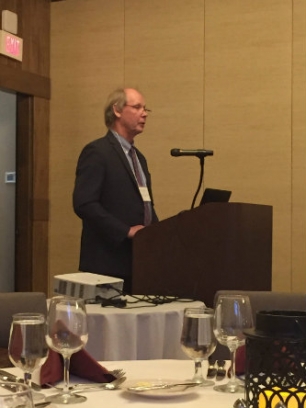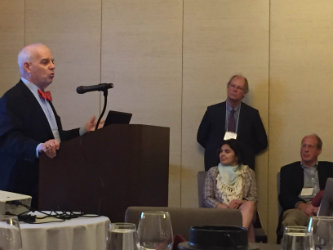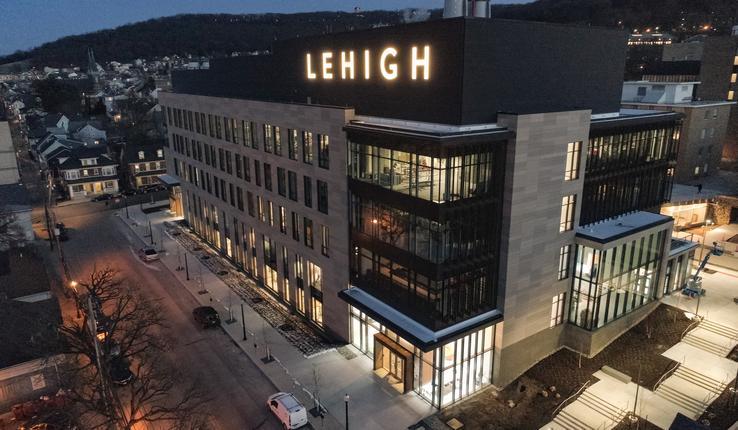Lehigh Hosts Workshop on the Convergence of Materials Research and Multi-Sensory Data Science
Lehigh last fall announced a $3 million institutional investment in the Nano/Human Interface Presidential Engineering Research Initiative, an effort that proposes to develop a human-machine interface that will improve scientists’ ability to visualize and interpret the vast amounts of data generated by scientific research. A partnership between Lehigh, the Ohio State University and the Army Research Laboratory, the initiative was approved by Lehigh President John D. Simon and Provost Patrick V. Farrell, and brings together scientists from across such disciplines as materials science, computer science, physics, psychology and bioengineering.
As part of the initiative, Lehigh and Ohio State in June hosted a three-day National Science Foundation-sponsored workshop at Bear Creek Mountain Resort in Macungie, Pa. The workshop was organized by Nancy Carlisle, assistant professor of psychology; Kate Arrington, associate professor of psychology; and Jeffrey Rickman, professor of materials science and engineering and also of physics. Workshop topics included a “roadmap of the key issues”: data analytics, human computer interactions, grand-challenge problems and the development of new tools, including the Nano/Human Interface.
“The goal of the workshop was to bring together researchers from a wide range of disciplines including materials science, bioengineering, computer science and cognitive science to look for places where research in these fields can converge,” said Carlisle. “... Bringing different perspectives together can let each group of researchers see their work in a new light, and increase the pace of scientific discovery.”
Said Rickman: "The format of the workshop was designed to spur interactions among the various constituencies, including natural and social scientists, as well as engineers. For example, we included several ‘big data’ problems, and these problems generated in-depth discussions of important issues and led to many proposed solutions. We were very pleased with the high level of participation, and I expect that the workshop initiated future collaborations."
Alton D. Romig, Jr. '75 '77G '79 Ph.D., chief executive of the National Academy of Engineering and member of the Dean's Advisory Council of Lehigh’s P.C. Rossin College of Engineering and Applied Science, gave the plenary address. Martin Harmer, professor of materials science and engineering and leader of the initiative, introduced Romig.
“When we had our [Nano/Human Interface] project funded by President Simon … to bring together elements of computer science and materials science and human sciences, I went to Al for advice and support and he actually was the one that really made the most influence in terms of engagement, bringing in expertise in human sciences,” said Harmer. “He really made a strong case for me when we first spoke about the importance of engaging human science into engineering. It made a big impact on me.”
Romig discussed the history and role of the National Academies of Sciences, Engineering and Medicine, as well as areas of current focus of the National Academy of Engineering and how the nano/human interface fits into the larger picture. The Academy, he said, recently conducted a study about what engineering research centers will look like in the future.
“What came back was about a convergence of engineering, computation, the physical sciences, life sciences, cognitive sciences, all the sorts of things that are happening here in this workshop,” Romig said. “So this is really incredibly timely. The time is right. The government [and] industry recognize that this is where the future is—it’s at the interfaces of all these various disciplines. So you’re one of the first to really be diving into this, and I think the opportunities for you are really quite great.”
Converging disparate disciplines, said Carlisle, is key to advancing new methods in materials science.
“An example of how these seemly disparate areas can converge is in developing visualizations of data from materials. When a materials scientist is gathering data about the nanoscale structure of a material (literally measuring the atomic structure of something they have created), it can be hard for them to know when they have gathered enough data from an electron microscope,” she explained. “Typically, they gather some data and then look at that data offline when they have time to think about it as well as other data they have gathered. Generating new ways of visualizing data in materials science could help researchers gather data more effectively, so the researchers would know if they have the right kind of data while they are still on the electron microscope, and speed up the process of evaluating materials. But these visualizations have to be correctly interpreted by humans if they are going to help. Computer science can help interpret the data and pull out key details while a materials scientist is still in the process of gathering the data, and cognitive science can evaluate whether humans can understand this visualization and whether they incorporate that information into their decision-making.”
This work, said Harmer in his introduction, is not easy.
“Bringing all these disciplines together is very, very difficult. It’s hard. We’re out of our comfort zone. We’re going to be struggling to bring all this together. And that’s what makes it worthwhile. … If it’s not difficult, then somebody else would have done it. … And so I really want to applaud all of the members here for coming here today to give this workshop.”
Said one workshop participant in a post-workshop survey: “The presentations and discussions were fascinating and filled me with a host of new ideas that are already changing how I think and work.”
Posted on:






